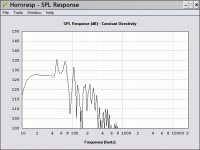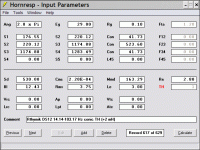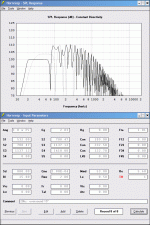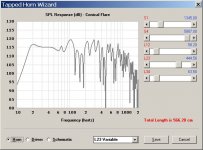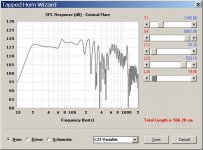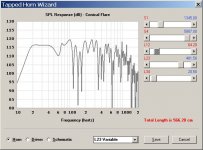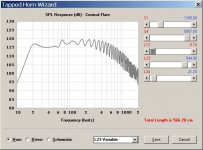Has anyone considered some of the Rythmik drivers for TH use? I'm presently planning to build a couple of smaller THs for PA use. The major issue with THs that I've encountered in Hornresp is related to diaphram displacement. Given the large displacement peaks above the horn cutoff, most drivers hit xmax way before they run into their power limits. In trying to squeeze out the most performance, I came across the following driver from Rythmik:
http://www.rythmikaudio.com/DS12driver.html
This driver has an xmax of roughly 35mm, (if I am reading their specs correctly). The BL is a bit on the low side, but overall, not bad for around 130 dB from a single 12" driver (roughly 350W).
This driver also has a servo sensing coil and Rythmik sells one custom servo controller amps. I wonder if that might be of use in helping to control displacement or for taming out some of those anomalies at the top of the TH's bandpass.
http://www.rythmikaudio.com/DS12driver.html
This driver has an xmax of roughly 35mm, (if I am reading their specs correctly). The BL is a bit on the low side, but overall, not bad for around 130 dB from a single 12" driver (roughly 350W).
This driver also has a servo sensing coil and Rythmik sells one custom servo controller amps. I wonder if that might be of use in helping to control displacement or for taming out some of those anomalies at the top of the TH's bandpass.
craigwalsh said:Has anyone considered some of the Rythmik drivers for TH use?
I'm presently planning to build a couple of smaller THs for PA use.
This driver has an xmax of roughly 35mm........
The BL is a bit on the low side, but overall, not bad for around 130 dB from a single 12" driver (roughly 350W).
I wonder if that might be of use in helping to control displacement or for taming out some of those anomalies at the top of the TH's bandpass.
Not me..........
Its specs doesn't seem all that conducive to a small PA app.
Xmax is a one way spec, so ~17.78 mm.
FWIW, the BL is too low for the rest of its specs, so none to be trusted IMO, which they shouldn't be for a horn design anyway.
Well, if I'm understanding what it does, then it doesn't much matter what the speaker's response looks like or how accurate its specs as long as it doesn't run out of gain BW for the signal input. If true, then you can shrink it for a small PA app since you won't need to worry about how smooth/flat its response.
GM
Shiva-X is on sale now, 135USD, 54mm Xmax p-p, SPL 84.5db...but maybe Qts 0.47 is on the high side fore TH ???
Roughly, how would sensitivity be fore this driver in a TH ???
I am asking because I need to decide whether my future system should consist of an 18" woofer with no sub needed, or if I should use a 15" with better lower mids, but with the need of subs, which could be TH...but will they be good fore music only ???
Roughly, how would sensitivity be fore this driver in a TH ???
I am asking because I need to decide whether my future system should consist of an 18" woofer with no sub needed, or if I should use a 15" with better lower mids, but with the need of subs, which could be TH...but will they be good fore music only ???
GM said:
Not me..........
Its specs doesn't seem all that conducive to a small PA app.
Xmax is a one way spec, so ~17.78 mm.
FWIW, the BL is too low for the rest of its specs, so none to be trusted IMO, which they shouldn't be for a horn design anyway.
Well, if I'm understanding what it does, then it doesn't much matter what the speaker's response looks like or how accurate its specs as long as it doesn't run out of gain BW for the signal input. If true, then you can shrink it for a small PA app since you won't need to worry about how smooth/flat its response.
GM
Thanks for clarifying Xmax. Hornresp's help file states that it displays the one-way maximum (1/2 wave) displacement. I get it now.
Rythmik lists a couple of other 12" drivers with higher BL. It would seem those might be useful for TH, no?
So, some issues come to mine. In the effort to identify high output for say around 30 Hz low cut, it seems as though the limiting factor is Xmax. Is this correct? If so, what 12" driver has the highest Xmax that would be useful for a TH alignment? Second, how do TH alignments deal with bass transients (like kick drum) compared to standard bass horns or vented enclosures? In other words, does the TH require that the signal fed to them have roughly symetric 1/2 waves for each cycle? Finally, I don't see why servo sensing couldn't be used to counteract the displacement peaks that limit the BW of the TH.
Thanks all! This has been very informative.
You're welcome!
Hmm, just so we're on the same 'page', the DS12's specs indicate a higher BL than what's published and its specs are fine for a TH (see attached 2 pi design based on a calc'd BL), just not for meeting your app unless you make multiple smaller ones and stack them, which of course still eats up trunk/whatever space and increases driver cost, though the trade-off is greater dynamic headroom due to the extra drivers.
Yes, all else being equal, Xmax (~10 % distortion) up to Xmech (bottoming out) is a design's limiting output factor, but an acoustically larger one can match it with less Xmax, ergo less power input, so it depends.
Not familiar with all the various drivers available and just because it has a high Xmax doesn't necessarily mean it can handle the high compression loading at high excursions without excessive distortion, so better IMO to use a proper prosound horn driver in a PA app and if it won't play loud enough, make more of them unless some other type such as a car audio 'sub' driver has a known reliability in a TH PA app.
Pretty much the same as a BLH and 'blows the doors off' a vented alignment as TD shows in his TH white paper: http://www.danleysoundlabs.com/pdf/danley_tapped.pdf
GM
Hmm, just so we're on the same 'page', the DS12's specs indicate a higher BL than what's published and its specs are fine for a TH (see attached 2 pi design based on a calc'd BL), just not for meeting your app unless you make multiple smaller ones and stack them, which of course still eats up trunk/whatever space and increases driver cost, though the trade-off is greater dynamic headroom due to the extra drivers.
Yes, all else being equal, Xmax (~10 % distortion) up to Xmech (bottoming out) is a design's limiting output factor, but an acoustically larger one can match it with less Xmax, ergo less power input, so it depends.
Not familiar with all the various drivers available and just because it has a high Xmax doesn't necessarily mean it can handle the high compression loading at high excursions without excessive distortion, so better IMO to use a proper prosound horn driver in a PA app and if it won't play loud enough, make more of them unless some other type such as a car audio 'sub' driver has a known reliability in a TH PA app.
Pretty much the same as a BLH and 'blows the doors off' a vented alignment as TD shows in his TH white paper: http://www.danleysoundlabs.com/pdf/danley_tapped.pdf
GM
Attachments
After building a tapped horn, I built a pair of bandpass subs using the exact same woofer, in an enclosure half the size. Are you curious what the subjective difference is between the two?
Then read this:
http://www.diyaudio.com/forums/showthread.php?threadid=114340&goto=newpost
Then read this:
http://www.diyaudio.com/forums/showthread.php?threadid=114340&goto=newpost
A couple of quick questions.
I have been modeling a wide range of drivers using hornresp and I have noted that a lot of drivers seem to benefit greatly in the area of smoothness of response by making the L1 distance significantly larger than L3. Has anyone actually implemented something like that? If so how did you lay it out and how did it perform?
Also I am considering using 1/2" OSB for my initial trials due to the 1/3 lower cost versus plywood or particle board. How might such construction color my results?
I have been modeling a wide range of drivers using hornresp and I have noted that a lot of drivers seem to benefit greatly in the area of smoothness of response by making the L1 distance significantly larger than L3. Has anyone actually implemented something like that? If so how did you lay it out and how did it perform?
Also I am considering using 1/2" OSB for my initial trials due to the 1/3 lower cost versus plywood or particle board. How might such construction color my results?
Hmm, seems like it should be the other way around in which case Tom Danley has. See his DTS-20 patent application someone posted here awhile back.
I imagine it will buzz if not heavy/inert enough and it will lose some of its gain, especially down low, if it can 'breathe' at higher SPL due to the walls flexing.
GM
I imagine it will buzz if not heavy/inert enough and it will lose some of its gain, especially down low, if it can 'breathe' at higher SPL due to the walls flexing.
GM
I've recenty aquired an Oversound MB 15-450 which seems to have pretty similar specs to the Eminence 4012 but it's 15":
http://www.oversound.com.br/index.php?pag=../loja/loja_produto&cat=123&pro=3348
Now, it appears that the specs are incomplete, it's missing things like BL, Cms and Rms. Is there a way of calculating these from the other values or am I going to have to use one of these "woofer tester" systems?
http://www.oversound.com.br/index.php?pag=../loja/loja_produto&cat=123&pro=3348
Now, it appears that the specs are incomplete, it's missing things like BL, Cms and Rms. Is there a way of calculating these from the other values or am I going to have to use one of these "woofer tester" systems?
Thanks very much.Sabbelbacke said:Here you go:
Anyway, doesn't seem like a bad driver, hopefully it should cope with horn loading ok as it's intended for PA use. It does do 20Hz pretty well but the box ending up a little large at 15 cubic feet. The grey graph is a horn around half the size, but much less 20Hz output, this would be more suited to music than HT.
Attachments
Well it was pretty late when I was running those sims.  I took a closer look this afternoon and it looks like what is happening is that by moving the driver further from the throat (relative to its distance from the mouth) we are smoothing out the penultimate bump and evening the response in that first 8va at the expense of the next octave up thus restricting us to only about one 8va range.
I took a closer look this afternoon and it looks like what is happening is that by moving the driver further from the throat (relative to its distance from the mouth) we are smoothing out the penultimate bump and evening the response in that first 8va at the expense of the next octave up thus restricting us to only about one 8va range.
Not worth it I think unless a specific application warrants. Pics show what I mean.
The "normal" results where I tried to get the best combination of extension, smoothness and bandwidth while having the mouth far enough away from the driver to allow either choice of exit axis. Careful choice of crossover should give more than 2 octaves with bumps only about 2dB or so.
Not worth it I think unless a specific application warrants. Pics show what I mean.
The "normal" results where I tried to get the best combination of extension, smoothness and bandwidth while having the mouth far enough away from the driver to allow either choice of exit axis. Careful choice of crossover should give more than 2 octaves with bumps only about 2dB or so.
Attachments
And just for giggles I thought I would try putting the driver right at the throat (i.e. firing right into the end of the horn like a normal horn) but with the rear of the driver firing into the mouth ala tapped horn. Interesting. If you can handle a fair amount of ripple there is quite a bit of bandwidth there.
Attachments
MikeHunt79 said:...........it's missing things like BL, Cms and Rms. Is there a way of calculating these from the other values.........
Yes, Hornresp will calculate them by inputting Sd, Vas, Re, Qes, Qms in the appropriate fields.
GM
Recently I built a bandpass sub, and much to my surprise, it seemed louder than my tapped horn. Even though the tapped horn was bigger, and used the same driver.
This was quite a shock, so I researched things, and I think I've solved the mystery.
The problem is that almost everyone is modeling their tapped horns in eigth space, and that's just ridiculously optimistic. In addition, the excursion simulations from horn response seem a bit suspect I'm afraid
While the jury is out on which program accurately models excursion, I am confident that anyone who compares a tapped horn modeled in eighth space to a vented box simulation from any other program, is going to get bogus results.
Here's how I came to this conclusion:
http://www.diyaudio.com/forums/showthread.php?postid=1597059#post1597059
This was quite a shock, so I researched things, and I think I've solved the mystery.
The problem is that almost everyone is modeling their tapped horns in eigth space, and that's just ridiculously optimistic. In addition, the excursion simulations from horn response seem a bit suspect I'm afraid
While the jury is out on which program accurately models excursion, I am confident that anyone who compares a tapped horn modeled in eighth space to a vented box simulation from any other program, is going to get bogus results.
Here's how I came to this conclusion:
http://www.diyaudio.com/forums/showthread.php?postid=1597059#post1597059
Mashaffer,
I've recently figured out how to sim the TH's in Hornresp. ( Thanks to David McBean, and all the others contributing here!)
I would like to suggest that whatever driver you are working with you try this as a baseline ( it's been working for me, and I stumbled across it.):
Start with S1 at about 1/2 of Sd, input any conical expansion you please, end up with S4 at about 2X Sd.
Start with the throat L1 at about 1/2 of the Dia. of the driver ( the driver truly at the side of the throat ) L2 to whatever length required to tune low as you desire, and L3 30-60Cm from the mouth.
bring up the tapped horn wizard and "Play" the sliders to smooth out the response you desire.
One Caveat: make sure to check the excursion graph, I've found when simulating a 20 Hz Horn with small drivers that the excursion tends to exceed X-max below the horn tuning, so a subsonic filter may be required to protect your driver.
I have been amazed at the variety of drivers I have been able to sim, with very good looking results.....now if it will cool of enough to get out in the shop and make some sawdust....
I've recently figured out how to sim the TH's in Hornresp. ( Thanks to David McBean, and all the others contributing here!)
I would like to suggest that whatever driver you are working with you try this as a baseline ( it's been working for me, and I stumbled across it.):
Start with S1 at about 1/2 of Sd, input any conical expansion you please, end up with S4 at about 2X Sd.
Start with the throat L1 at about 1/2 of the Dia. of the driver ( the driver truly at the side of the throat ) L2 to whatever length required to tune low as you desire, and L3 30-60Cm from the mouth.
bring up the tapped horn wizard and "Play" the sliders to smooth out the response you desire.
One Caveat: make sure to check the excursion graph, I've found when simulating a 20 Hz Horn with small drivers that the excursion tends to exceed X-max below the horn tuning, so a subsonic filter may be required to protect your driver.
I have been amazed at the variety of drivers I have been able to sim, with very good looking results.....now if it will cool of enough to get out in the shop and make some sawdust....
- Home
- Loudspeakers
- Subwoofers
- Collaborative Tapped horn project
